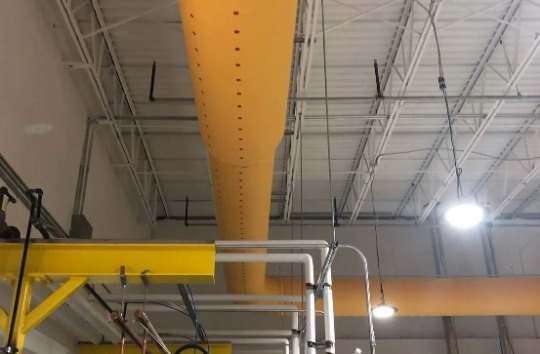Don't wanna be here? Send us removal request.
Text
How Does A Fabric Duct Spot Cooling System Work?

A fabric duct spot cooling system works by utilizing a network of fabric ducts to distribute cool air directly to specific areas. Unlike traditional air conditioning systems that cool an entire space, fabric duct spot cooling systems focus on cooling specific zones or localized areas where cooling is needed the most.
The fabric ducts are designed with precision-engineered nozzles or vents that release cool air in a controlled and targeted manner. These nozzles or vents can be strategically placed to ensure the cool air reaches the desired spots, providing efficient and effective cooling.
The fabric ducts are made from high-quality materials that are permeable and breathable, allowing for the even distribution of cool air. The fabric itself acts as a diffuser, ensuring that the cool air is dispersed evenly throughout the area. This eliminates the need for additional air distribution systems, such as ductwork or diffusers, reducing installation and maintenance costs.
In addition to delivering cool air, fabric duct spot cooling systems can also incorporate filtration systems to improve indoor air quality. This ensures that the air being circulated is clean and free from contaminants, creating a healthier and more comfortable environment.
Overall, the working principle of a fabric duct spot cooling system involves the precise delivery of cool air through strategically placed fabric ducts, providing targeted and efficient cooling to specific areas or zones.
0 notes
Text
Benefits of fabric duct spot cooling

One of the key benefits of fabric duct spot cooling is its cost efficiency. Traditional ductwork can be expensive to install and maintain, requiring extensive labor and materials. In contrast, fabric ducts are lightweight and easy to install, reducing installation costs significantly. Additionally, fabric duct spot cooling allows for easy reconfiguration and modification, making it a flexible and cost-effective solution for businesses that often undergo layout changes.
Another advantage of fabric duct spot cooling is its energy efficiency. By delivering cool air directly to specific areas, fabric ducts eliminate the need for excessive cooling throughout the entire space. This targeted approach reduces energy consumption and lowers utility bills. Additionally, fabric ducts have lower pressure drop compared to traditional ductwork, resulting in reduced fan power requirements and further energy savings Spot Cooling.
Improved air distribution is another significant benefit of fabric duct spot cooling. Traditional ductwork often results in uneven air distribution, with some areas receiving too much cold air while others remain warm. Fabric ducts, on the other hand, ensure even air distribution by utilizing a combination of porous fabric and strategically placed vents. This creates a more comfortable and consistent indoor environment, enhancing productivity and well-being for occupants.
0 notes
Text
Energy Efficiency and Cost Savings of Fabric Duct Spot Cooling

One of the biggest advantages of fabric duct spot cooling is its energy efficiency and cost savings. Traditional cooling systems often cool an entire space, regardless of occupancy levels or specific cooling needs. This can result in significant energy waste and unnecessary expenses. Fabric duct spot cooling, on the other hand, allows for precise temperature control in specific areas, ensuring that cooling is only provided where it's needed Spot Cooling.
By eliminating the need to cool unoccupied or less frequently used spaces, businesses can achieve substantial energy savings and reduce their carbon footprint. Additionally, fabric ducts have lower air resistance compared to traditional metal ductwork, resulting in reduced energy consumption and lower operating costs.
Fabric duct spot cooling also offers the advantage of zoning, allowing businesses to divide their spaces into different cooling zones based on specific requirements. For example, in a large office with varying cooling needs, fabric ducts can be strategically placed to provide more cooling near heat-emitting equipment or areas with high foot traffic, while reducing cooling in less occupied areas. This zoning capability not only improves energy efficiency but also enhances comfort levels for employees and customers.
1 note
·
View note